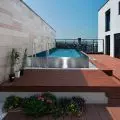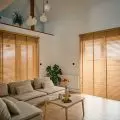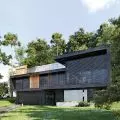A {tag:studenci} from Opole University of Technology is the author of a project for an agritourism farm and horse stud in the village of Pogórze in Opole province. Her goal was to create a quiet place for relaxation, where guests can experience the charms of rural life and benefit from hippotherapy.
The project is an engineering thesis carried out at the Faculty of Construction and Architecture of the Opole University of Technology under the direction of Dr. Anna Szczegielniak.
The premise of the project was to create a quiet place in a peaceful area, which is intended as an answer to the growing problem of stress and fast-paced life. The area is designed for people who want to take advantage of rural life and those with physical and mental fitness problems. The author has created a space designed for treatment through hippotherapy - therapy with a horse.
There is a stable on the farm and hippotherapy is provided
© Paulina Wilde
Recreation in contact with nature
The stage preceding the design was a number of spatial and urban analyses, which allowed the student to better understand the specifics of the site and the context in which she planned the buildings. In the immediate vicinity of the designed buildings, the predominant type of development is a homestead, in which buildings are located around a courtyard. The author decided to incorporate the project into the urban layout of the village, giving the objects a similar form to the surrounding buildings.
The farmhouse fits into the landscape of the village
© Paulina Wilde
The basis for the construction of an agritourism farm is a suitable plot of land - large enough to ensure the proper development of animals and near natural forests and meadows, which provides opportunities for off-road horseback riding and walking. Such a place is an area in the village of Pogórze, Opolskie province. An additional attraction that attracts visitors is the Moszna Castle located only 10 km from the designed establishment," says the author.
The site chosen by Paulina Wilde meets the needs of future users (families with children, people with health problems), whose priority is to relax in an inexpensive place surrounded by nature. A place where one can ride horses and participate in hippotherapy. Visitors to the farm also have the opportunity to taste homemade products and organic food straight from the garden, and learn about the rural rhythm of life and the duties of the farmer, including the care and feeding of animals.
The body of the residential buildings is reminiscent of a country cottage
© Paulina Wilde
residential buildings in the form of cottages
The author divided the area of the designed farm into two parts: the part consisting of buildings on the side of the road and the part intended for horses placed on the western side of the plot. On the southern side, she designed a two-story residential house for the host and a house for guests, connecting them with each other by a glass terrace with wooden gates, which serves as a connector and a place for meetings and recreation.
The form and elevations of the buildings are reminiscent of rural buildings
© Paulina Wilde
The form of the designed buildings refers to a country cottage. The facade is covered with white plaster, and the gabled roof is covered with red tiles. Large windows illuminate the rooms, and wooden shutters have appeared in the window openings.
The entrance to the residential building leads through the so-called lauba, or porch. This place is a characteristic element of a country house, it protects from rain and sun and acts as a dirt lock, explains Paulina Wilde.
floor plans of the host house and guest house
© Paulina Wilde
The guest facility has been adapted for the elderly and people with disabilities. The location of the buildings has been adjusted to the sides of the world to make the most of natural light.
stable with riding school
In the northern part of the farm are two barns, used for storing crops, hay and straw supplies. Their facade was made in a similar character to the farmhouse - white plaster walls, red tile roofing and wooden sliding gates around the opening.
The stable was divided into three tracts
© Paulina Wilde
The view closes with a stable with a riding arena. The building, made of wood, has a simple form with a symmetrical gable roof, and adequate light is provided by skylights. The stable is divided into three tracts - a corridor in the middle and horse stalls placed on both sides of it. This arrangement ensures eye contact between the animals, making them calmer. Each box is 3 meters by 3.5 meters, so that the horse can move freely in it. There are also additional rooms in the stable - a saddling room with riding equipment, a station for washing and combing the horse, a feed room and a solarium as part of rehabilitation.
indoor riding arena
© Paulina Wilde
Right next to the stable is an indoor riding arena, which is used for riding lessons and horse training. This building separates part of the buildings from the rest of the plot, where pastures for horses, paddocks, a carousel and lunge (warm-up and training of horses) and a swimming pool (recreation and rehabilitation for horses) are located.
The project aims to spread the use of agritourism farms
© Paulina Wilde
Between the buildings there was a green square with small architecture - a gazebo, a playground and a place for a bonfire. To introduce a noise barrier and a friendly environment, the development area was supplemented with numerous tall and low greenery.
Agritourism is still less popular in Poland than in western Europe. My project was aimed at spreading the use of agritourism farms. Such a foram provides an opportunity for relaxation, hippotherapy and horseback riding in close natural surroundings, as well as learning about the realities of life in the countryside," the author concludes.











































